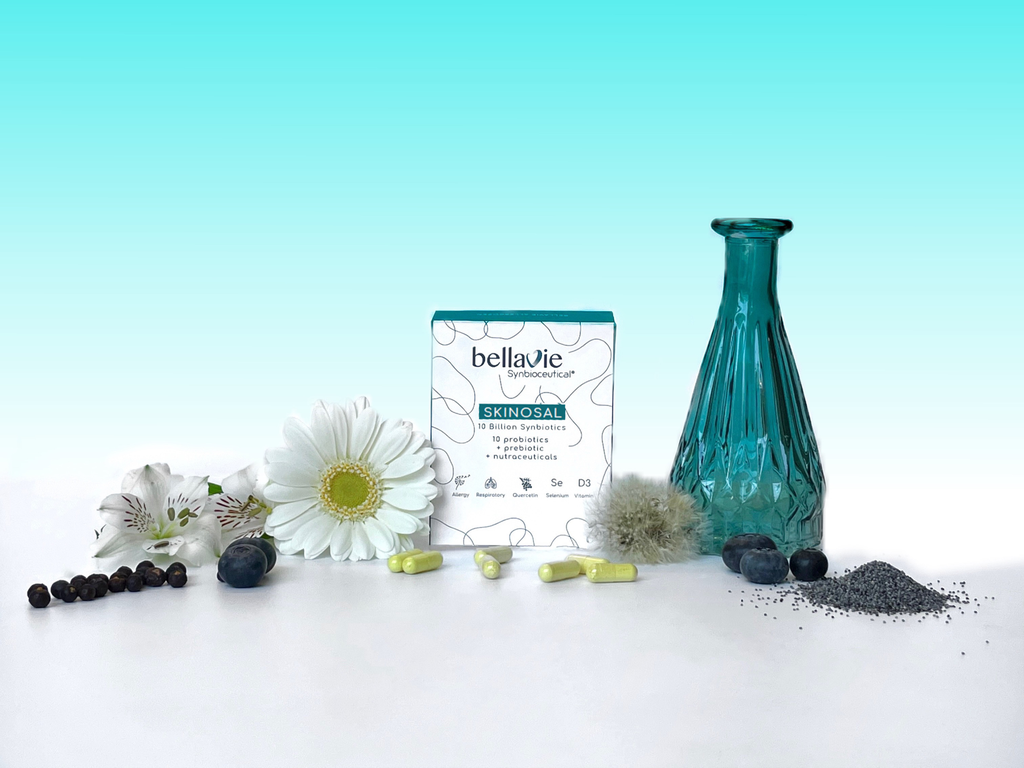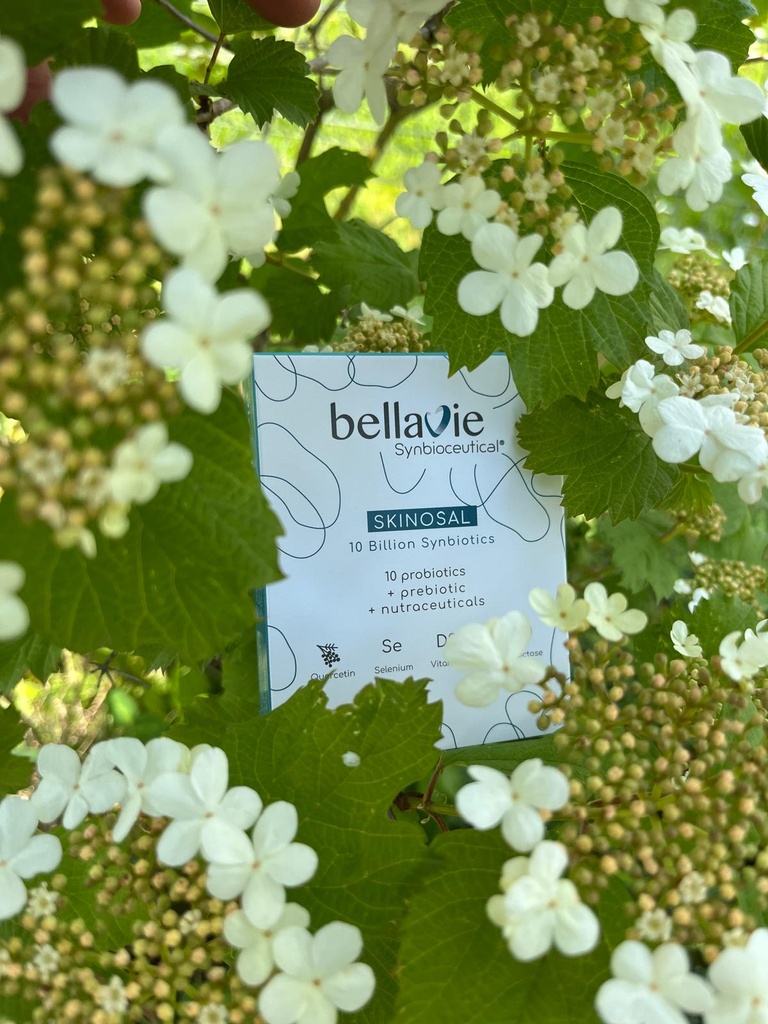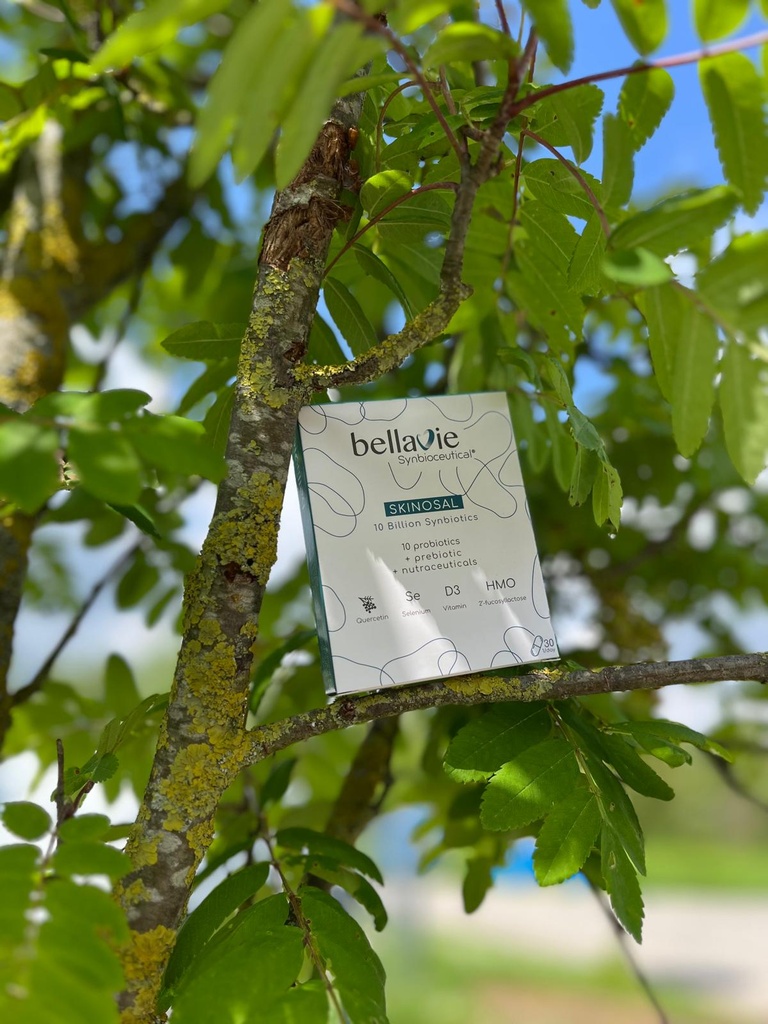- Alle Produkte
- BellaVie SKINOSAL
BellaVie SKINOSAL
/shop/bel-07-bellavie-skinosal-384BellaVie SKINOSAL ist ein Gesundheitspräparat, das entwickelt wurde, um Ihr allgemeines Gleichgewicht täglich zu unterstützen.
Enthält 10 lebende probiotische Stämme, Präbiotika und Nutrazeutika, die jeweils aufgrund ihrer anerkannten gesundheitlichen Vorteile ausgewählt wurden.
Die Formel wurde mit essentiellen Darmbakterien entwickelt, um ein Gleichgewicht der Darmmikrobiota zu fördern.
Die Formel wird durch Präbiotika ergänzt, die in Synergie mit den probiotischen Stämmen wirken und deren Aktivität verstärken.
BellaVie SKINOSAL enthält Quercetin, Selen und Vitamin D3, die zu einem normalen Gleichgewicht von th1/th2 beitragen.
Erhältlich in Schachteln mit 30 Kapseln.
Bedingungen und Konditionen
30 Tage Geld-zurück-Garantie
Versand: 2-3 Geschäftstage
50,000+ companies run Odoo to grow their businesses.
Join us and make your company a better place.
Coming soon
10 Probiotische Stämme
Bacillus coagulans–LMG 6326
Lactobacillus rhamnosus–ATCC 53103
Lactobacillus acidophilus–ARS B-3208
Lactobacillus bulgaricus–CNCM I-5435
Lactobacillus salivarius–LMG 9477
Lactobacillus casei–CNCM I-5094
Streptococcus thermophilus–CNCM I-4912
Bifidobacterium bifidum–CNCM I-5091
Bifidobacterium infantis–LMG 25627
Bifidobacterium breve200BN–CNCM I-5112
Fasern
HMO (2'-fucosyllactose) : 30 mg
Nutraceuticals
Quercetin >95%
VitaminD3 = 5 μg/cap (100000 IU/g) / 200 IU parcap = 100%NRV*
Selenium = 55 μg/cap = 100%NRV*(Selenium enriched yeast at 2000 μg/g)
*Nutritional Reference Value
- 100% belgische Produktion
- Lebende Stämme: Alle unsere Formeln wurden mit mikrobenstämmen entwickelt, die lebende Bakterien sind..
- Innovative Formel: Die Formel wurde für spezifische Anwendungen entwickelt. Das Produkt enthält mikrobenstämme, Ballaststoffe und wissenschaftlich gut beschriebene Nutrazeutika für spezifische gesundheitliche Vorteile.
- Breites Spektrum: CFU = Colony Forming Units (koloniebildende Einheiten), die eine Schätzung der Anzahl lebensfähiger Bakterien in einer Probe ermöglichen.
- Hohe Konzentration: Jede Kapsel enthält eine große Menge an lebenden Mikroorganismen. Die Menge wird in CFU (Colony Forming Units) angegeben. Jede Kapsel enthält 10,000,000,000 CFU.
- Pflanzliche Kapseln und Halal-Zertifizierung: die Kapseln sind vegan, halal und koscher zertifiziert.
- Magensaftresistente Kapseln: Um die mikrobenstämme vor der Säure des Magens zu schützen, verwenden wir spezielle Kapseln mit einer höheren Resistenz gegen diese Säure. Die Menge der lebenden mikrobenstämme im Darm wird daher höher sein.
- Spezifische Nutrazeutika: die Nutrazeutika werden entsprechend der gewünschten Wirkung ausgewählt.
- Hitzebeständige Stämme: Bacillus Coagulans ist ein weltbekannter Stamm, der eine optimale Temperaturbeständigkeit bis zur Zone 4B bietet. Diese Zone steht für ein sehr feuchtes und intensives Klima.
- Feuchtigkeitsresistente Verpackung: unsere Verpackungen (Kapseln und Blister) mit geringem Feuchtigkeitsgehalt wurden ausgewählt, um die mikrobenstämme vor Feuchtigkeit zu schützen und sie länger leben zu lassen.
1 Kapsel pro Tag mit einem großen Glas Wasser einzunehmen.
Möglichkeit zur Erhöhung auf 1 Kapsel zweimal täglich bei Bedarf oder wie empfohlen.
BellaVie-Kapseln können zu jeder Tageszeit eingenommen werden.
An einem kühlen, trockenen Ort aufbewahren.
Kühlung wird empfohlen, wann immer möglich.
Da die Kapseln getrocknete lebende Mikroorganismen enthalten, empfiehlt es sich große Temperatur- und Feuchtigkeitsschwankungen zu vermeiden.
Außerhalb der Reichweite von Kindern aufbewahren.
Es wurden keine unerwünschten Nebenwirkungen gemeldet.
Vorsichtsmaßnahmen: Wenn Ihr Kind an einer Krankheit leidet oder verschreibungspflichtige Medikamente einnimmt, fragen Sie Ihren Arzt, bevor Sie dieses Produkt verwenden. Überschreiten Sie nicht die angegebene Tagesdosis. Dieses Nahrungsergänzungsmittel ist kein Ersatz für eine abwechslungsreiche und ausgewogene Ernährung und eine gesunde Lebensweise.
Nicht verwenden, wenn am selben Tag andere 2'-Fucosyllactose-haltige Lebensmittel verzehrt werden
Referenzen:
1. Aafa.org. 2022. Allergies and Allergic Reactions | AAFA.org | AAFA | Allergies. https://www.aafa.org/allergies.aspx
2. Cleveland Clinic. 2022. Allergies: Types, Symptoms, Causes & Treatments. https://my.clevelandclinic.org/health/diseases/8610-allergy-overview
3. Michail, S., 2009. The role of Probiotics in allergic diseases. Allergy, Asthma & Clinical Immunology, 5(1).
4. Du, X., Wang, L., Wu, S., Yuan, L., Tang, S., Xiang, Y., Qu, X., Liu, H., Qin, X. and Liu, C., 2019. Efficacy of probiotic supplementary therapy for asthma, allergic rhinitis, and wheeze: a meta-analysis of randomized controlled trials. Allergy and Asthma Proceedings, 40(4), pp.250-260.
5. RDN, C., 2022. Probiotics for Asthma: An Update - International Probiotics Association. International Probiotics Association. https://internationalprobiotics.org/asthma/
6. National Eczema Association. 2022. Probiotics: The Search for Bacterial Balance. https://nationaleczema.org/search-bacterial-balance/
7. Jensen, G., Cash, H., Farmer, S. and Keller, D., 2017. Inactivated probiotic <em>Bacillus coagulans</em> GBI-30 induces complex immune activating, anti-inflammatory, and regenerative markers in vitro. Journal of Inflammation Research, Volume 10, pp.107-117.
8. Proquest.com. 2022. ANTI-INFLAMMATORY AND IMMUNOMODULATORY EFFECTS OF BACILLUS COAGULANS UNIQUE IS2 - ProQuest https://www.proquest.com/openview/de2d19fcfbb134900ca10fcaba87f0b7/1?pq-origsite=gscholar&cbl=136102 .
9. 2022. [online] Available at: https://www.karger.com/Article/FullText/515352 .
10. Cukrowska, B., Ceregra, A., Maciorkowska, E., Surowska, B., Zegadło-Mylik, M., Konopka, E., Trojanowska, I., Zakrzewska, M., Bierła, J., Zakrzewski, M., Kanarek, E. and Motyl, I., 2021. The Effectiveness of Probiotic Lactobacillus rhamnosus and Lactobacillus casei Strains in Children with Atopic Dermatitis and Cow’s Milk Protein Allergy: A Multicenter, Randomized, Double Blind, Placebo Controlled Study. Nutrients, 13(4), p.1169. - https://www.ncbi.nlm.nih.gov/pmc/articles/PMC8066586/
11. Wickens, K., Black, P., Stanley, T., Mitchell, E., Barthow, C., Fitzharris, P., Purdie, G. and Crane, J., 2012. A protective effect of L<i>actobacillus rhamnosus</i>HN001 against eczema in the first 2 years of life persists to age 4 years. Clinical & Experimental Allergy, 42(7), pp.1071-1079. - https://pubmed.ncbi.nlm.nih.gov/22702506/
12. Elmadfa, I., Klein, P. and Meyer, A., 2010. Immune-stimulating effects of lactic acid bacteria <i>in vivo</i> and <i>in vitro</i>. Proceedings of the Nutrition Society, 69(3), pp.416-420. - https://www.cambridge.org/core/journals/proceedings-of-the-nutrition-society/article/immunestimulating-effects-of-lactic-acid-bacteria-in-vivo-and-in-vitro/072C2E5023504BFC338584413A3C1AF2
13. Jing, W., Liu, Q. and Wang, W., 2020. <i>Bifidobacterium bifidum</i> TMC3115 ameliorates milk protein allergy in by affecting gut microbiota: A randomized double‐blind control trial. Journal of Food Biochemistry, 44(11). – <No study/No link in the power point>
14. Niers, L., Timmerman, H., Rijkers, G., Bleek, G., Uden, N., Knol, E., Kapsenberg, M., Kimpen, J. and Hoekstra, M., 2005. Identification of strong interleukin-10 inducing lactic acid bacteria which down-regulate T helper type 2 cytokines. Clinical <html_ent glyph="@amp;" ascii="&amp;"/> Experimental Allergy, 35(11), pp.1481-1489. - https://pubmed.ncbi.nlm.nih.gov/16297146/
15. Mendes, E., Acetturi, B., Thomas, A., Martins, F., Crisma, A., Murata, G., Braga, T., Camâra, N., Franco, A., Setubal, J., Ribeiro, W., Valduga, C., Curi, R., Dias-Neto, E., Tavares-de-Lima, W. and Ferreira, C., 2017. Prophylactic Supplementation of Bifidobacterium longum 51A Protects Mice from Ovariectomy-Induced Exacerbated Allergic Airway Inflammation and Airway Hyperresponsiveness. Frontiers in Microbiology, 8. - https://www.ncbi.nlm.nih.gov/pmc/articles/PMC5604069/
16. Ren, J., Zhao, Y., Huang, S., Lv, D., Yang, F., Lou, L. ... Bachert, C. (2018). Immunomodulatory effect of Bifidobacterium breve on experimental allergic rhinitis in BALB/c mice. Experimental and Therapeutic Medicine, 16, 3996-4004. https://www.spandidos publications.com/10.3892/etm.2018.6704
17. Kekkonen, R., Kajasto, E., Miettinen, M., Veckman, V., Korpela, R. and Julkunen, I., 2008. Probiotic Leuconostoc mesenteroides ssp. cremoris and Streptococcus thermophilus induce IL-12 and IFN-γ production. World Journal of Gastroenterology, 14(8), p.1192. - https://www.ncbi.nlm.nih.gov/pmc/articles/PMC2690666/
18. Morisset, M., Aubert-Jacquin, C., Soulaines, P., Moneret-Vautrin, D. and Dupont, C., 2010. A non-hydrolyzed, fermented milk formula reduces digestive and respiratory events in infants at high risk of allergy. European Journal of Clinical Nutrition, 65(2), pp.175-183. - https://pubmed.ncbi.nlm.nih.gov/21081959/
19. FARID, R., 2004. Selenium status is decreased in patients with allergic diseases*1A new focus on an old trace element as a possible modifier of Th1/Th2 dichotomy. Journal of Allergy and Clinical Immunology, 113(2), p.S161. - https://doi.org/10.1016/j.jaci.2004.01.010.
20. Richards, L., 2022. Allergies: Types, Symptoms, Causes & Treatments. [online] Cleveland Clinic. Available at: https://my.clevelandclinic.org/health/diseases/8610-allergy-overview
21. Du, X., Wang, L., Wu, S., Yuan, L., Tang, S., Xiang, Y., Qu, X., Liu, H., Qin, X. and Liu, C., 2019. Efficacy of probiotic supplementary therapy for asthma, allergic rhinitis, and wheeze: a meta-analysis of randomized controlled trials. Allergy and Asthma Proceedings, 40(4), pp.250-260. - https://pubmed.ncbi.nlm.nih.gov/31262380/
22. Malik, A., Menon, B., Dar, Y., Garg, T., Bhatia, H. and Kaur, C., 2015. Placebo controlled trial of vitamin D supplementation in allergic rhinitis. 5.3 Allergy and Immunology,. - https://erj.ersjournals.com/content/46/suppl_59/PA2559
23. Shishehbor F., Behroo L., Broujerdnia M.G., Namjoyan F., Latifi S.-M. Quercetin effectively quells peanut-induced anaphylactic reactions in the peanut sensitized rats. Iran. J. Allergy Asthma Immunol. 2010;9:27–34. [PubMed] [Google Scholar] - <No study/No link in the power point>
24. Oliveira T.T., Campos K.M., Cerqueira-Lima A.T., Carneiro T.C.B., da Silva Velozo E., Melo I.C.A.R., Figueiredo E.A., de Jesus Oliveira E., de Vasconcelos D.F.S.A., Pontes-de-Carvalho L.C., et al. Potential therapeutic effect of Allium cepa L. and quercetin in a murine model of Blomia tropicalis induced asthma. DARU J. Pharm. Sci. 2015;23 doi: 10.1186/s40199-015-0098-5. [PMC free article] [PubMed]. - https://www.ncbi.nlm.nih.gov/pmc/articles/PMC4344790/
25. Rogerio A., Kanashiro A., Fontanari C., da Silva E., Lucisano-Valim Y., Soares E., Faccioli L. Anti-inflammatory activity of quercetin and isoquercitrin in experimental murine allergic asthma. Inflamm. Res. 2007;56:402–408. doi: 10.1007/s00011-007-7005-6. - https://pubmed.ncbi.nlm.nih.gov/18026696/
26. Kimata M., Shichijo M., Miura T., Serizawa I., Inagaki N., Nagai H. Effects of luteolin, quercetin and baicalein on immunoglobulin E-mediated mediator release from human cultured mast cells. Clin. Exp. Allergy. 2000;30:501–508. doi: 10.1046/j.1365-2222.2000.00768.x. - https://pubmed.ncbi.nlm.nih.gov/10718847/







